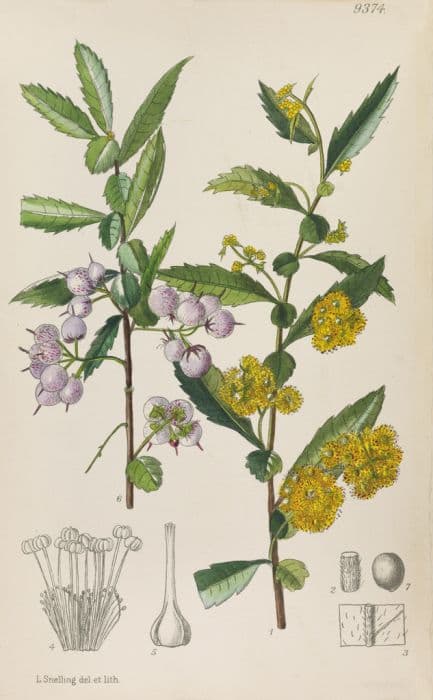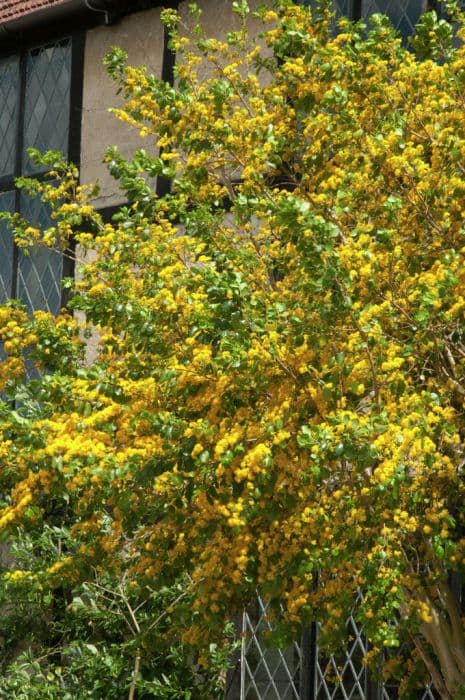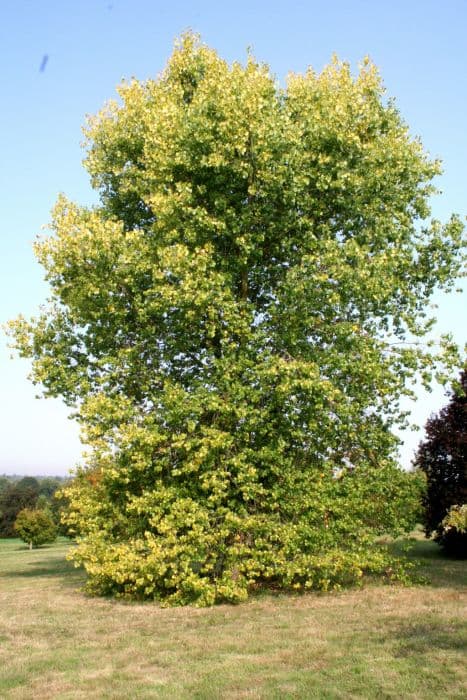Variegated boxleaf Azara Azara microphylla 'Variegata' (v)

ABOUT
Azara microphylla 'Variegata', commonly known as Variegated Boxleaf Azara, is an evergreen shrub known for its striking foliage and ornamental qualities. The small, oval to round leaves of this plant are arranged in a dense, layering fashion along the slender, arching branches. Creating a fine-textured appearance, the leaves exhibit a unique variegation pattern — they are a rich, glossy green in color with irregular creamy white edges, making the plant visually compelling throughout the year. During late winter to early spring, the Variegated Boxleaf Azara produces tiny, fluffy-looking flowers that are inconspicuous but highly fragrant, adding a sweet scent to the garden reminiscent of vanilla or chocolate. The flowers are often hidden beneath the variegated foliage, which adds to the plant's allure, inviting closer inspection to discover the hidden blooms. After flowering, the plant will sometimes bear small, round fruits which start off as green and may mature to an orange or red hue, depending on the specific conditions. The delicate branching pattern coupled with the attractive foliage makes the Variegated Boxleaf Azara a popular choice as a specimen plant, for hedging, or used to create textural contrast in mixed garden borders. Its foliage serves as an excellent backdrop for other colorful plants, and it is valued for its year-round interest and the visual impact it brings to any garden setting.
About this plant
 Names
NamesSynonyms
Variegated Boxleaf Azara, Variegated Small-Leaf Azara
Common names
Azara microphylla 'Variegata'
 Toxicity
ToxicityTo humans
The Azara microphylla 'Variegata', commonly known as the Variegated Boxleaf Azara, is not widely recognized for its toxicity to humans. There is little information available about its potential effects if ingested. However, as with many plants, it's generally advised to avoid ingesting parts of ornamental plants due to the potential for unknown toxins or irritants that could cause gastrointestinal discomfort or an allergic reaction. Always exercise caution and keep plants out of reach of children who might accidentally consume them.
To pets
The Variegated Boxleaf Azara, also known as Azara microphylla 'Variegata', does not have a well-documented toxic profile for pets, such as cats and dogs. There is limited information available about its potential toxicity, and it is not commonly listed as a toxic plant. However, cautious pet owners should prevent their pets from ingesting any part of the plant. If a pet does consume parts of this plant and shows signs of illness—a change in behavior, vomiting, or diarrhea—contacting a veterinarian is recommended.
 Characteristics
CharacteristicsLife cycle
Perennials
Foliage type
Evergreen
Color of leaves
Variegated
Flower color
Yellow
Height
10-15 feet (3-4.5 meters)
Spread
6-8 feet (1.8-2.4 meters)
Plant type
Shrub
Hardiness zones
8
Native area
South America
Benefits
 General Benefits
General Benefits- Aesthetic Value: Azara microphylla 'Variegata', commonly known as the Variegated Boxleaf Azara, is cherished for its ornamental variegated leaves, which add visual interest to gardens and landscapes.
- Habitat for Wildlife: It provides shelter and potentially food in the form of berries for birds and other wildlife.
- Low Maintenance: Once established, Variegated Boxleaf Azara tends to be low maintenance, requiring minimal care and pruning to maintain its shape.
- Drought Tolerance: The plant has moderate drought tolerance, making it suitable for regions with water restrictions or those looking to conserve water.
- Year-Round Interest: With its evergreen foliage and occasional small yellow flowers, it ensures that there is always some greenery in the garden, even in the winter months.
- Compact Growth: This cultivar often exhibits a neat, compact growth habit that makes it ideal for small gardens or as part of a mixed border.
- Windbreak: Due to its dense growth, it can be used as a windbreak or hedge, providing protection for more sensitive plants in the garden.
- Adaptability: Variegated Boxleaf Azara can adapt to a range of soil types, though it prefers well-drained conditions.
- Urban Tolerant: It is relatively tolerant of urban pollution and so is suitable for city gardens and streetscapes.
- Screening: Its dense foliage makes it an excellent choice for creating privacy screens or masking unsightly views.
 Medical Properties
Medical PropertiesThis plant is not used for medical purposes.
 Air-purifying Qualities
Air-purifying QualitiesThis plant is not specifically known for air purifying qualities.
 Other Uses
Other Uses- As a natural insect repellent: The aromatic foliage of the Azara can be used to deter certain insects when planted near outdoor seating areas.
- Creating natural fences: With its dense growth, Azara can be shaped into living fences or privacy screens for gardens and yards.
- Crafting bonsai: Due to its small leaves and variegated foliage, Azara is suitable for the art of bonsai, providing an attractive miniature tree.
- Component in perfumes: The subtle fragrance of Azara flowers can be used in creating natural perfumes or scented oils.
- Floral arrangements: The striking variegated leaves lend a unique visual contrast in floral decorations and arrangements.
- Educational use: The plant is ideal for teaching botanical concepts such as variegation and plant adaptation in gardens or classrooms.
- Habitat support: Azara provides shelter and food for small birds and beneficial insects, promoting biodiversity.
- Culinary garnish: While not widely known, the leaves can be used for decorative purposes in gourmet dishes.
- Photography subject: The plant's variegated leaves and small yellow flowers make it an attractive subject for botanical photography.
- Artistic inspiration: Artists can draw inspiration from the distinctive patterns and form of Azara for various types of artwork.
Interesting Facts
 Feng Shui
Feng ShuiThe plant Azara is not used in Feng Shui practice.
 Zodiac Sign Compitability
Zodiac Sign CompitabilityThe plant Azara is not used in astrology practice.
 Plant Symbolism
Plant Symbolism- Delicacy: The fine, variegated leaves of the Boxleaf Azara represent delicacy and attention to detail.
- Adaptability: As a plant that can thrive in various conditions, the Boxleaf Azara symbolizes adaptability and resilience.
- Charm: With its aesthetically pleasing foliage, Boxleaf Azara is seen as a symbol of charm and attraction.
- Sensitivity: The light fragrance of its flowers, which can be sensitive to the environment, signifies sensitivity and a gentle approach.
- Simplicity: Despite its ornamental appearance, Boxleaf Azara is easy to care for, representing simplicity and unpretentious beauty.
 Water
WaterThe Variegated Boxleaf Azara prefers consistently moist soil, so it should be watered thoroughly whenever the top inch of soil feels dry to the touch. This will likely be about once a week, but can vary based on temperature and humidity. During the growing season in spring and summer, the plant might need more frequent watering, possibly twice per week. Use approximately 1 gallon of water per watering session for a medium-sized plant to ensure the soil is moistened throughout the pot. Adjust this amount as necessary for smaller or larger plants, but avoid waterlogging the soil.
 Light
LightThe Variegated Boxleaf Azara thrives in bright, indirect sunlight. It is best placed in a spot where it can receive partial shade, as too much harsh sunlight can cause damage to the leaves. An east-facing or west-facing window with filtered light is ideal. However, it can also adapt to lower light conditions, which makes it versatile for indoor environments.
 Temperature
TemperatureThe Variegated Boxleaf Azara does well in a temperature range between 50°F and 75°F. Avoid exposing the plant to temperatures below 50°F as it can cause harm. This plant prefers a mild climate and should be protected from extreme cold and frost, which could be damaging if the temperature drops to freezing or below.
 Pruning
PruningThe Variegated Boxleaf Azara should be pruned to maintain shape and encourage bushier growth. Pruning is best done in late winter or early spring before new growth begins. Trim back any dead or overly long branches, and thin out the plant's interior to improve air circulation. It is generally not necessary to prune this plant frequently, so once a year will suffice.
 Cleaning
CleaningAs needed
 Soil
SoilFor the Variegated Boxleaf Azara, a soil mix that provides good drainage and is rich in organic matter is ideal. The pH level should be slightly acidic to neutral, ranging between 6.0 and 7.0. A combination of peat, compost, and coarse sand or perlite can create a well-draining yet moisture-retentive mix suitable for this plant.
 Repotting
RepottingVariegated Boxleaf Azara should be repotted every 2 to 3 years to refresh the soil and accommodate root growth. It's less about the frequency of repotting and more about monitoring the size and health of the plant to determine when it's necessary to move it to a larger pot.
 Humidity & Misting
Humidity & MistingThe Variegated Boxleaf Azara thrives in moderate to high humidity levels, ideally between 40% to 60%. Maintaining consistent humidity within this range will help keep the plant healthy and encourage lush foliage growth.
 Suitable locations
Suitable locationsIndoor
Keep in bright, indirect light and mist occasionally.
Outdoor
Place in dappled sunlight; shelter from extreme cold.
Hardiness zone
8-10 USDA
 Life cycle
Life cycleAzara microphylla 'Variegata', commonly known as the 'Variegated Boxleaf Azara', begins its life cycle as a seed that germinates in early spring under the right conditions of warmth and moisture. The seedling stage follows, where it develops its first leaves and root system. As the plant enters the vegetative stage, it grows rapidly, forming a dense, evergreen shrub with variegated leaves, and it may take several years to reach maturity. During the reproductive stage, small, yellow, fragrant flowers bloom in late winter to early spring, attracting pollinators. After pollination, the flowers develop into small, inedible berries. The mature plant will continue to grow and bloom annually, with proper care, for many years before eventually senescing.
 Propogation
PropogationPropogation time
Spring-Early Summer
Propogation: Azara microphylla 'Variegata', commonly referred to as variegated boxleaf azara, is most effectively propagated by semi-hardwood cuttings. This method involves taking cuttings from the plant during the summer months when the current season's growth has started to mature but is not yet fully hardened. A cutting typically measures between 4 to 6 inches (approximately 10 to 15 centimeters) and contains several sets of leaves. The lower leaves are removed, and the cut end of the stem is dipped into a rooting hormone powder or solution to encourage root development. Afterward, the cutting is placed into a well-draining soil medium, such as a mixture of peat and perlite, and kept under high humidity conditions. A plastic cover or a propagator can help maintain the moisture levels. Roots usually develop within a few weeks, after which the new plants can be gradually acclimatized to less controlled conditions before being potted on or planted out.









